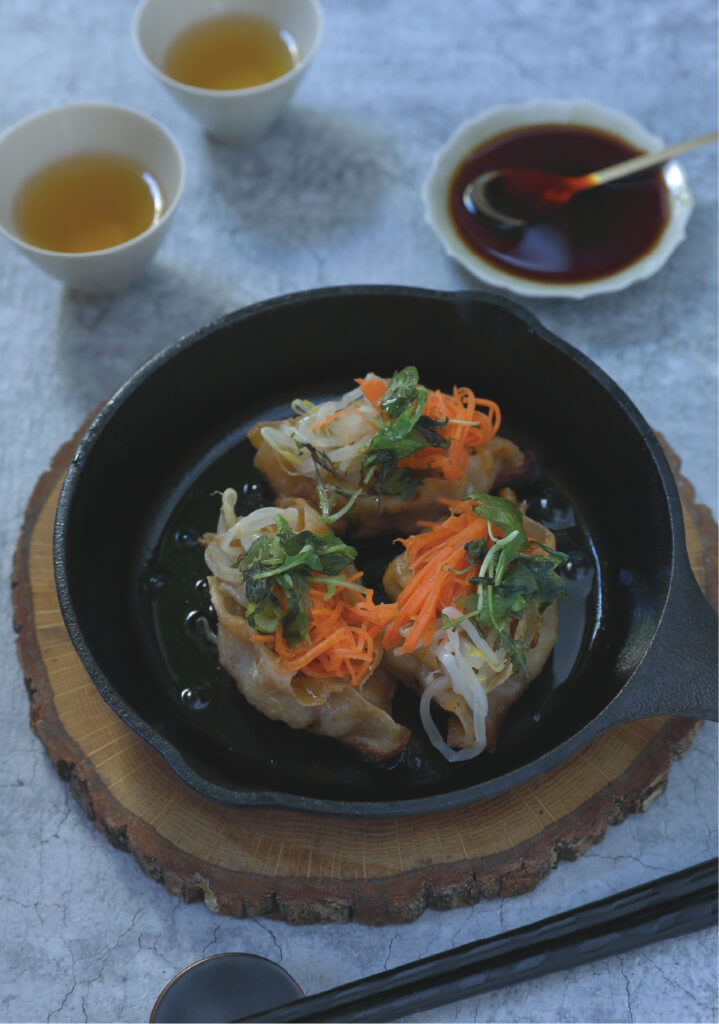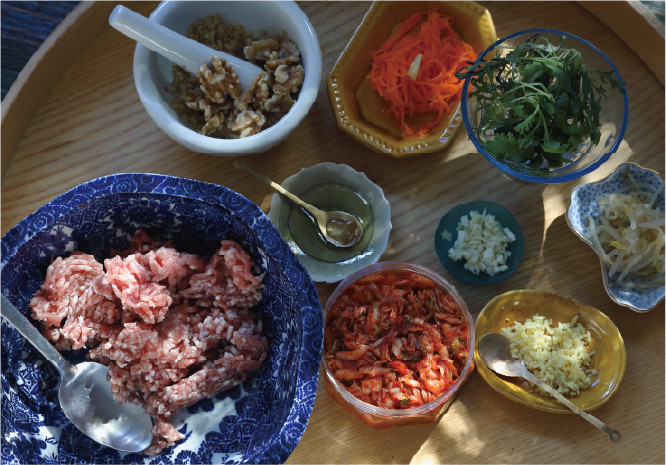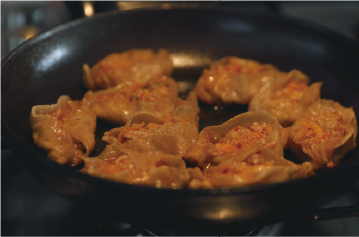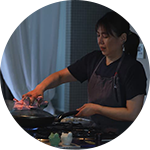韓国編
dumplings|2025.4.24

「旅する餃子」韓国編。
辛いイメージでの韓国料理だが、
そこにはまだ私たちが知らない
奥深い味がありそう。
さて、どんな餃子となるのか。


カラダにも美味しい、人気の韓国料理。
相変わらずの韓流ブーム。いや、ブームは終わり、いまでは完全に定着した感もある。韓国料理や韓国食材の店が軒を連ねる新大久保は連日、多くの人でにぎわい、K-POPは勢いがあるし、ドラマや映画も人気。小説家のハン・ガンはノーベル文学賞を受賞するなど、文化面での充実度は目を見張るものがある。そして、韓国料理もいまや日本の日常の食べ物となっている。
韓国料理は薬食同源が根底にあるという。食べるものは全て薬になるという考え方。五味(甘・辛・酸・苦・塩)、五色(赤・緑・黄・白・黒)、五法(焼く・煮る・蒸す・炒める・生)をバランスよく献立に取り入れることを良しとしている。
また薬膳料理も多く食べられていて、日本でもお馴染みのサムゲタンもそのひとつに数えられる。他にもカラダにいいといわれる発酵食品のキムチは地域ごとの味があり、韓国の食事には欠かせないものとなっている。さらにご飯、スープ、メイン料理、おかずが並び、食卓はとても華やか。食べる前から元気になりそうで、食べたらさらに元気になる。それが韓国料理。
Delicious and Healthy: Korean Food.
The Korean boom hasn’t faded—in fact, it’s now part of everyday life. Shin-Okubo, with its Korean restaurants and grocery stores, buzzes daily with visitors, and K-pop, Korean dramas, and films remain hugely popular. Korean culture is thriving—novelist Han Kang even won the Nobel Prize. Korean food, too, has become a staple in everyday Japanese life.
Korean cuisine is rooted in the idea that food is medicine—what you eat can heal you. It emphasizes balance across five tastes (sweet, spicy, sour, bitter, salty), five colors (red, green, yellow, white, black), and five preparation methods (grilling, boiling, steaming, stir-frying, raw).
Herbal dishes like samgyetang (ginseng chicken soup) are common, and kimchi, packed with probiotics and regional flair—is a must-have. A typical Korean meal includes rice, soup, a main dish, and various sides, making a festive spread. It’s food that energizes just by looking at it—and even more when you eat it. That’s the power of Korean cuisine.




キムチの辛さと蜂蜜の甘さが特徴的。
さて、ということで今回は韓国流の「くるみハチミツとキムチの餃子」のレシピをご紹介。ちなみに、韓国語にはモンゴルから入ってきた「マンドゥ」と呼ばれる餃子があるというが、今回はそれとは関係のないオリジナル餃子。
材料は、皮には砕いたくるみとハチミツと小麦粉を使用。餡の具材には豚肉とキムチ、ごま油を。そしてトッピングには、豆もやしとにんじんのナムルとベビーリーフ。つくり方は、
①小麦粉にくるみと蜂蜜を混ぜ合わせて皮を作る。
②肉とキムチと胡麻油をあえて皮で包み閉じずに開けたまま焼く。
③ナムルをトッピングする。
さてさて、どんなお味にできたかな?
なるほど、キムチが入った餡はしっかり韓国風。トッピングのナムルもいい仕事をしている。そして何より、ハチミツとくるみを使うことで、焼いたときに糖分と油分がカリッとさせている。これはご飯が進みそうな、食卓の定番になる餃子だ。
The heat of kimchi and the sweetness of honey.
With that in mind, here’s a Korean-inspired recipe for walnut, honey, and kimchi dumplings. While Korea has its own dumplings called mandu, which came from Mongolia, today’s recipe is an original creation.
The wrapper: crushed walnuts, honey, and flour. The filling: ground pork, kimchi, and sesame oil. The toppings: soybean sprout and carrot namul, with baby greens. To make:
1.Mix flour, crushed walnuts, and honey for the wrappers.
2. Combine the pork, kimchi, and sesame oil for the filling, place it in the wrapper, and pan-fry without sealing the edges.
3. Top with namul and greens.
So, how does it taste?
The filling with kimchi brings bold Korean flavor and the namul topping adds a perfect accent. Best of all, the honey and walnuts caramelize into a crispy finish. It’s the kind of dumpling you’ll crave with a bowl of rice—sure to become a new favorite.

《料理家》 松井まり子 Mariko Matsui
株式会社De-De
Senior Art Director/Graphic Designer/Food Stylist
アートディレクター、フードスタイリストとして活動する傍ら2024年にはDe-De GYOZAもスタート。




